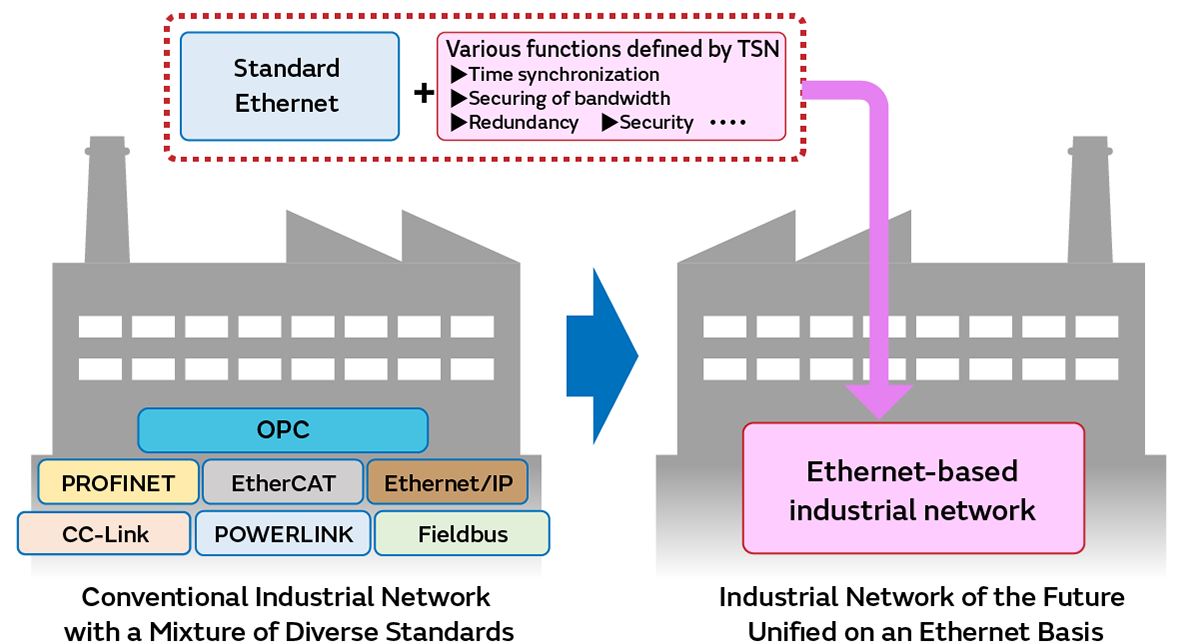Effective and efficient manufacturing is performed in smart factories while exchanging data between various systems and equipment in factories and also between core information systems, clouds, and other technologies in companies. When exchanging data inside and outside a factory, network technology called an “industrial network” is used. This technology is different from that used in regular offices and homes. An industrial network is communications technology that improves data communication quality and reliability, real-time performance, security, and other elements to suit the quantity and content of the data handled and the purpose of use and the usage environment in the factory.
Ethernet, Wi-Fi and other networks have become fast enough to be able to transmit high-definition video data in real time in recent years. Even so, some aspects remain that make them difficult to use in factories from perspectives such as communications quality and reliability and real-time performance.
For example, it is frustrating when video takes time to be displayed despite clicking on the thumbnail of a video you want to watch on a video site. However, this may lead to an even more serious problem in a factory. For instance, what if a situation arises in which a system develops a malfunction and the arrival of an emergency stop signal is delayed despite it being sent? Defective products may continue to be made on-site. This may lead to enormous damage being suffered. A function that ensures such a situation does not arise is incorporated into network technology in industrial networks. Currently, industrial network technology is evolving from conventional control communications technology called a “field network” to Ethernet-based time-sensitive networking (TSN) that is even faster and easier to use in anticipation of the evolution of smart factories.
From the control of systems to line management and operation optimization over entire companies
There are two main types of industrial network used in factories (Fig. 1). One is a field network in which the control data of systems and equipment on the line and the data of sensors that detect the state of works in progress and other information is exchanged with a programmable logic controller (PLC). The other is a controller-to-controller network that connects between multiple PLCs and between systems that monitor lines.

Fig. 1: Industrial network configuration
Coordination is now also being taken with the core system that manages the operation status of multiple factories, the procurement of parts and materials across the entire company, inventory information, and other data in addition to an industrial network in factories in recent years. The information system network that forms the core system and the industrial network in the factory are located apart. Therefore, the two are also connected by a public network in many cases. Accordingly, they are connected via a firewall to protect highly confidential industrial information from cyber-attacks and other incidents.
Industrial networks have diverse standards with different characteristics
There are various standards with different characteristics, usage settings, and compatible devices for the protocols of industrial networks.
The controller area network (CAN) in-vehicle network standard, the RS-485 serial communications standard, and other standards were used at first in the fieldbus with the development of factory automation. After that, FA device manufacturers and manufacturing industry groups proposed multiple unique standards to ensure development into a high-speed and highly reliable standard capable of being applied to even more advanced FA. Profibus, formulated as a standard by an industry group in Germany called PROFIBUS & PROFINET International, and other standards are widely used globally, whereas CC-Link, MECHATROLINK, and other standards are often used in Japan.
There are also many standards for controller-to-controller networks. These include PROFINET, EtherNet/IP, EtherCAT, Modbus TCP/IP, CC-Link IE Field, and Sercos III. The adoption of Ethernet-based systems is currently spreading in this field. All of the standards we just gave are Ethernet-based technologies. The reason Ethernet-based technologies have spread is that there is a focus on coordination with information system networks. It has become possible to manage and control all connected devices at once with an IP address by utilizing a data exchange standard called “OPC UA.”
Wireless communication is also widely utilized in factories
Smart factories are being built and digital transformation (DX) in companies is being implemented. This has led to diverse devices and equipment being connected via networks more than ever before. As a result, there is a need for new network technologies that can be applied to even more diverse devices and that can handle even more usage settings.
A standard technology has appeared in which various standards enable real-time communications in an Ethernet environment to meet such needs. This is TSN (Fig. 2). TSN is a technology that enables application to industrial use and makes it possible to unify communications in smart factories with just an Ethernet-based standard. It does this by incorporating various functions to meet the demands of the times in Ethernet used in office automation and other applications. These functions include time synchronization, securing of bandwidth to enable real-time communications, improvement of reliability by having redundancy, and an increase in security through the detachment of information leakage nodes.

Fig. 2: Unification of networks in a factory on an Ethernet-basis in TSN
There is also an increase in activity for the movement to connect systems and equipment placed in factories to networks by using wireless LAN, Bluetooth, and other short-range wireless communications. If sensors are connected wirelessly, it becomes possible to install them in places where they could not previously be installed. It also becomes easier to change the layout of the line. However, Wi-Fi and Bluetooth do not have the same communications quality and reliability as industrial networks. Accordingly, attempts have been made to use the fifth-generation mobile communications system (5G) that achieves ultra-high-speed, ultra-low delays, and multiple simultaneous connections in place of industrial networks. A local 5G system that grants a 5G base station license only within a specified area has started in Japan. It is anticipated that it will also become possible to use TSN technology in 5G that is expected to be used in smart factories. This will make data utilization in factories even more effective and efficient.
Courtesy: Murata








